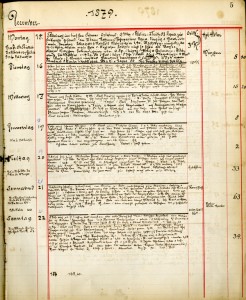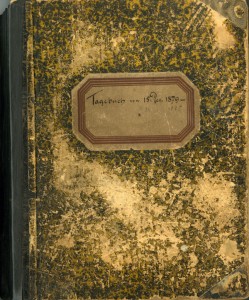Heine Diaries
Thanks to the donation of his grand daughter-in-law, Lea Heine, the MCHS owns the diaries of German born artist Friedrich Wilhelm Heine (1845 – 1921). On hundreds of pages containing his small handwriting, Heine wrote about his daily life in Milwaukee.
Heine arrived from Dresden in 1885 to overtake the job of an artistic leader in a Milwaukee panorama studio at 628 W.Wells Street. His diaries are the only known source showing step by step, how these giants of art history (46 feet high and 385 feet in circumference and their weight, when covered with paint, about 9 tons) were created, from preparing research and the first sketches, to the final varnish half a year later. Eight panoramas, partly showing battle scenes of the Civil War and partly paintings of Jerusalem with the crucifixion of Christ were painted from 1885 to 1888. The only surviving production we know of is the Battle of Atlanta which is still on display in Atlanta, Georgia.
source showing step by step, how these giants of art history (46 feet high and 385 feet in circumference and their weight, when covered with paint, about 9 tons) were created, from preparing research and the first sketches, to the final varnish half a year later. Eight panoramas, partly showing battle scenes of the Civil War and partly paintings of Jerusalem with the crucifixion of Christ were painted from 1885 to 1888. The only surviving production we know of is the Battle of Atlanta which is still on display in Atlanta, Georgia.
The Milwaukee studio worked just four years, when William Wehner, the investor of Milwaukee’s panorama company, lost his interest. Out of work, some artists went back to Germany, others like Heine, who had his family with him, remained for good and became American citizens. A dozen years later, some of the former employees created the panorama of the Battle of Manila Bay for Wehner in San Francisco, of which the MCHS owns the 1:10 version, designed before the enlargement to the original size.
As Heine died in 1921, the main part of the diaries is not about panorama painting, but the cultural and social life of his time, especially about the surviving of the artists. For instance, Richard Lorenz, famous as a painter of the Wild West, George Peter, who created the dioramas in Milwaukee’s Public Museum or Bernhard Schneider, who settled in Cedarburg as a landscape painter. Written day by day, not memories written years later in a reconciling review, these texts are a unique document about Milwaukee’s past.
The content of these books remained unknown for decades. Heine wrote in the old fashioned German of his time and he blended the Old German scripture with the letters used today, sometimes in the same word. Even his contemporaries moaned about his lousy handwriting though he was otherwise a wonderful calligraphist. To save paper he not only pressed over 60 lines on a page meant for 30, he additionally used his personal shortenings. Only with the possibility of a computer enlargement can these texts be deciphered.
Michael Kutzer, native German speaker, himself a painter and studied art historian, has been working for a few years to transcribe these texts. First, making them readable and then adding a summary in English for each page.
This is an ongoing project that will take years to complete, but it will yield valuable insight and knowledge about Milwaukee’s past seen through the eyes of a contemporary.

